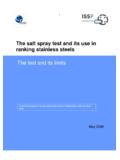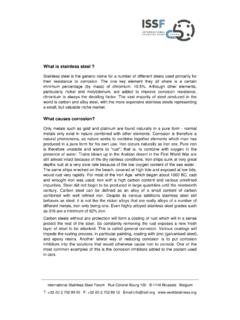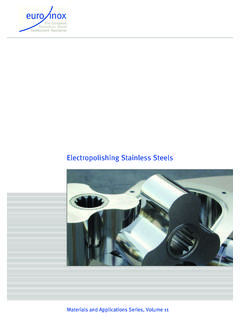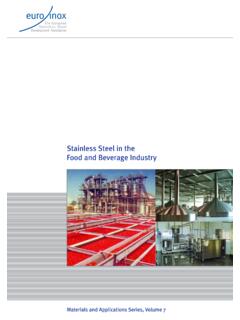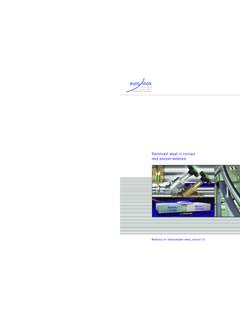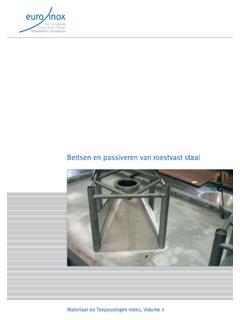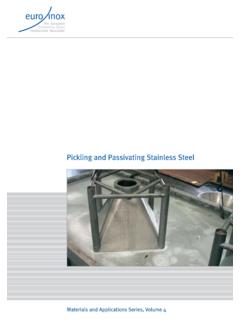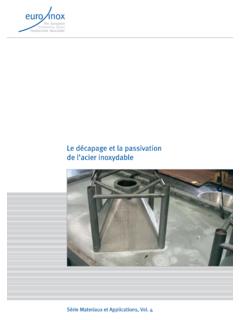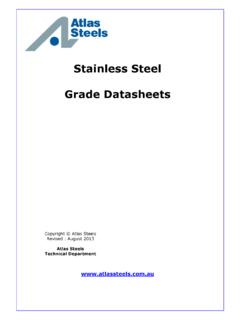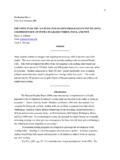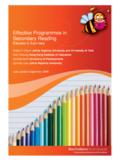Transcription of Stainless Steel in Contact with Other Metallic …
1 Stainless Steel in Contactwith Other Metallic MaterialsMaterials and Applications Series, Volume 10 Diamant Building Bd. A. Reyers 80 1030 Brussels Belgium Tel. +32 2 706 82-67 Fax -69 e-mail ISBN 978-2-87997-263-3 Metal1 AnodeMetal2 CathodeElectrolytee- Contact with Other Metallic MATERIALSEuro InoxEuro Inox is the European market development asso-ciation for Stainless Steel . Members of Euro Inox include: European Stainless Steel producers national Stainless Steel development associations development associations of the alloying elementindustriesThe prime objectives of Euro Inox are to create aware-ness of the unique properties of Stainless Steel and to fur-ther its use in existing applications and in new achieve these objectives, Euro Inox organizes confer-ences and seminars and issues guidance in printed andelectronic form to enable architects, designers, speci-fiers, fabricators and end users to become more familiarwith the material .
2 Euro Inox also supports technical andmarket Acciai Speciali Stainless BelgiumArcelorMittal Stainless Stainless Steel Association (BSSA) Edelstahl de D veloppement de l Inox ( ) Chromium Development Association (ICDA) Molybdenum Association (IMOA) elik Derne i (PASDER) Unia Dystrybutor w Stali (PUDS) with Other Metallic MATERIALST able of contents1 Introduction22 The principles of galvanic corrosion33 Relevant factors and Electrolyte Wetting duration and The kinetics of electrode Cathode and anode area84 Practical experience in different Water and sewage Components in atmospheric Stainless Steel in building and Stainless Steel in transport applications18 Frequently asked questions205 Preventing galvanic corrosion226 Literature23 Photo credits.
3 Atomium asbl / vzw, Brussels (B)Centro Inox, Milan (I)Bundesanstalt f r Materialpr fung und -forschung, Berlin (D)David Cochrane, Sidcup (UK)Beno t Van Hecke, Hasselt (B)Outokumpu, Tornio (FIN)Thomas Pauly, Brussels (B)Christoph Seeberger, Munich (D)ThyssenKrupp Nirosta GmbH, Krefeld (D)Sch ck Bauteile GmbH, Baden-Baden (D) Viega GmbH & Co. KG, Attendorn (D) Stainless Steel in Contact with Other Metallic MaterialsMaterials and Applications Series, Volume 10 ISBN 978-2-87997-263-3 Euro Inox 2009 Translated and adapted from ARLT, N. / BURKERT, A /ISECKE, B., Edelstahl Rostfrei in Kontakt mit anderenWerkstoffen (Merkblatt 829), D sseldorf, Informations-stelle Edelstahl Rostfrei, 4thedition 2005 PublisherEuro InoxDiamant Building, Bd.
4 A. Reyers 80,1030 Br ssel, BelgiumPhone +32 2 706 82 65 Fax +32 2 706 82 69 DisclaimerEuro Inox has made every effort to ensure that the infor-mation presented in this document is technically , the reader isadvised that the material con-tained herein is for general information purposes Inox, its members, specifically disclaim any liabili-ty or responsibility for loss, damage, or injury, resultingfrom the use of the information contained in this noticeThis work is subject to copyright. Euro Inox reserves allrights of translation in any language, reprinting, re-use ofillustrations, recitation and broadcasting. No part of thispublication may be reproduced, stored in a retrievalsystem or transmitted in any form or by any means,electronic, mechanical, photocopying, recording orotherwise, without the prior written permission of thecopyright owner, Euro-Inox, Luxembourg.
5 Violations maybe subject to legal proceedings, involving monetarydamages as well as compensation for costs and legalfees, under Luxemburg copyright law and regulationswithin the European Union. 2 Contact with Other Metallic MATERIALS1 IntroductionComplex design requirements can makeit necessary to combine different metallicmaterials within the same component. Also,chance combinations can often be found,governed only by the availability of, for in-stance, fasteners or shims. In certain cir-cumstances, such mixed- material designscan lead to corrosion in one of the partnermaterials. This phenomenon includes gal-vanic corrosion1, in which two differentmetals form a galvanic a result of the formation of galvanicelements, accelerated corrosion of the lessnoble material can occur.
6 The latter may thensuffer a corrosion rate far higher than that tobe expected withoutanycontact with thenobler partner metal. Corrosion-related dam-age such as unacceptable deterioration ofappearance, leaking tubes or failing fasten-erscan drasticallyreduce the service life ofacomponent and lead to premature re-placement. In most technical applications, Stainless Steel has the more positive corro-1 Accelerated corrosion of a metal, due to the effect of a corrosion ele-ment. Other factors include concentration elements, aeration elementsand active/passive potential of the metals in Contact ; hencethere is usually a corrosion hazard for thepartner risk of galvanic corrosion occurringdepends, however, on a multitude of the materials used, environmentand design are crucial.
7 It is therefore diffi-cult to make a priori judgments aboutthe compatibility of materials. The presentpublication describes the principles of galva-nic corrosion and the main parametersthat allow designers to estimate with Other Metallic MATERIALS naturally occur in the metal in isolation; how-ever, the corrosive attack on the anode isgreatly accelerated. In some cases, the for-mation of galvanic elements can lead to cor-rosion in materials that would otherwise becorrosion resistant in the environment inquestion. This can be the case for passivematerials such as aluminium, which can belocally polarised in a certain environment. Insuch cases, localised corrosion phenomenasuch as crevice corrosion or pitting corrosioncan be observed, which would not haveoccurred without the shift in potentialcaused by the formation of galvanic galvanic corrosion to occur, theremust be: different corrosion potentials ofthe metals within a given system; a conductive connection between thetwo metals; an electrically conductive humidityfilm (electrolyte) connecting both metalsFigure 1shows the three prerequisites ingraphic galvanic corrosion occurs, the less no-ble material the anode is preferentiallyattacked whilst the more noble material the cathode is even protected againstcorrosion.
8 In fact, the principle of cathodicprotection isbased on sacrificial anodesproviding protection from contactoftwo metals with differentpotentialsin an electricallyconductive solu-tion leads to a flow of electrons from theanode to the cathode. The electro-chemicalreactions are the same as those that would2 The principles of galvanic corrosionFigure 1 shows the three prerequi-sites in graphic 1e Metal 2 AnodeCathode4 Contact with Other Metallic MATERIALSC ontrary to widespread belief, the differ-ence of potential in an electrochemical cellalone is not a good indicator of the actualrisk of galvanic corrosion. It only indicateswhether or not such a risk has to be takeninto account.
9 In this context, it should beremembered that the numerous publishedtables of the standard potentials of metalsonly provide an approximation of differencesof potential. The decisive factor is not thedifference of potential observed under stan-dardised experimental conditions but ratherthe actual difference of potential under realoperating conditions. This is why empiricaltables of galvanic series have been producedfor typicalenvironments such as sea position the potentialofvariousmet-als in a given environment (Figure 2).Awarenessof the prerequisites of gal-vaniccorrosion and a proper understandingofthe examples in Figure 3make it possibleto determine preventive action, which will bediscussed in section iteAl lo y 625 / C-27 6Su pera ust eniti c sta inless ste elTita niumAlloy400 Aus tenit ic stai nl es s st eel grade1.
10 440 4 (316 L) , pa ssiv eNi cke lNi -Al Br onze90 /10 Cup ro- Nick elAl-br assCopp erAus ten itic st ainl es s ste el cast ingLea dTinCarbo n stee lCast st eelAl MgZin cAl um iniumMagne siu m-2 000-150 0-1 00 0-5000500 Potent ia l (m V SCE )Figure 2: The Galvanic Series insea-water at 10 C [11]Figure 3: Conditions in which galvanic corrosion cannot occur(Metal 1 = Anode, Metal 2 = Cathode)Metal 1 Metal 2 Metal 1 Metal 2 Metal 1 Metal 2 Metal 1 Metal electrically conductive metals with no difference of connection by an electrolyteCoatingGalvanic corrosion cannot occur ..5 Contact with Other Metallic MATERIALS3 Relevant factors and examplesAccording to Faraday s law, electro-chem-ical corrosion processes are directly relatedto charge transfer, the flow of or current densities are thereforefrequently used to measure corrosion.
